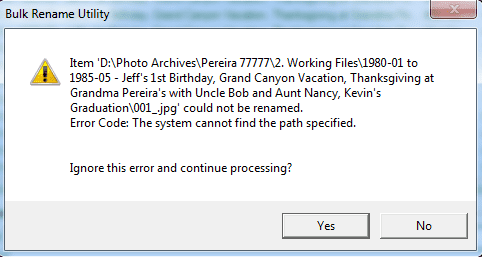

- BULK RENAME UTILITY TARGET ITEM ALREADY EXISTS HOW TO
- BULK RENAME UTILITY TARGET ITEM ALREADY EXISTS UPDATE
- BULK RENAME UTILITY TARGET ITEM ALREADY EXISTS CODE
- BULK RENAME UTILITY TARGET ITEM ALREADY EXISTS DOWNLOAD

To complete this tutorial and get the most out of it, you should be comfortable with the following concepts: In this project, you’ll use the second approach, which might be more intuitive and user-friendly, providing a better user experience.
BULK RENAME UTILITY TARGET ITEM ALREADY EXISTS CODE
You’ll also write some code to ensure that the GUI gets updated according to the file renaming progress and state. In this example, you’ll set up a progress bar to reflect the operation progress. The file renaming process needs to be connected with the application’s GUI so the user knows what is happening at any given time. To prevent GUI freezing issues, you’ll offload the renaming process to a worker thread using QThread. This might cause your application’s GUI to freeze. Depending on the number of files that you need to rename, the operation can take a considerable amount of time. Next, you need to code the functionality to load multiple files into your application and rename them in one go. rename() on that object to rename the associated file or directory. Once you have a Path object that points to a physical file or directory, you can call. Typically, you’ll use pathlib.Path to manage file and directory paths in your applications. This module provides classes that represent file system paths and allow operations on them. Note: Python 3.4 added pathlib to the standard library. In this tutorial, however, you’ll use pathlib for both tasks. For example, you have os.path to work with file system paths and os to use operating system functionalities, such as renaming files with os.rename(). When it comes to managing files and directories in Python, you have several options in the standard library. With this tool, your GUI creation process will be fast and productive. This tool provides a user-friendly interface to create GUIs by dragging and dropping graphical components (widgets) on a blank form. To create the application’s GUI, you’ll use Qt Designer.
BULK RENAME UTILITY TARGET ITEM ALREADY EXISTS UPDATE
BULK RENAME UTILITY TARGET ITEM ALREADY EXISTS DOWNLOAD
To download the project’s directory structure, click the link below:
BULK RENAME UTILITY TARGET ITEM ALREADY EXISTS HOW TO
You’ll see how to create these two files with Qt Designer and pyuic5 later in this tutorial. Go ahead and create this directory structure with all the files and modules except for window.ui and window.py.

README.md provides a general project description and instructions on installing and running the application.Here, rprename_project/ is the project’s root directory, where you’ll create the following files:


 0 kommentar(er)
0 kommentar(er)
